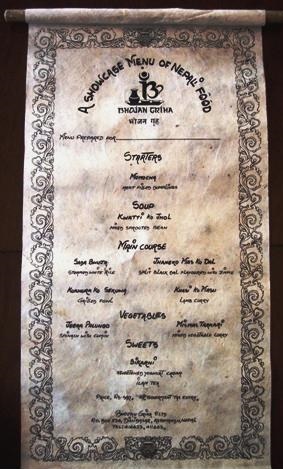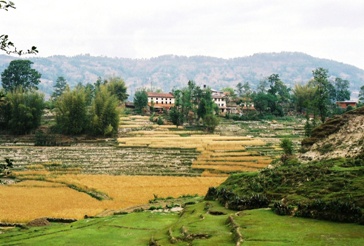
Well, a couple of days ago, something wondrous happened. I was rummaging through the poetry section of the library when a scroll wound around some twigs tumbled out from in between a couple of the books. I picked it up, feeling the familiar feel of coarse Himalayan fiber paper in my hand and smiled – remembering what the scroll contained. I unrolled it and was instantly thrown back in time. It was a menu from Bojhan Griha, a fantastic restaurant in the Dilli Bazar section of Kathmandu, Nepal.
It’s a startlingly simple menu, but as with all great restaurants – a simple menu often means that the chef has perfected a few of his or her best dishes and that you are likely to dine on some really marvelous food. Such is the case with Bojhan Griha where flavorful, butter-soft lamb is blanketed with a rich curry, resplendent with ginger, cinnamon, black pepper and accompanying vegetables, the quail and ducks are roasted to perfection and served with a mango-peppercorn sauce, and even the simple side dish of spinach overflows with the flavors of cumin, red pepper and just a hint of dill. Even the building that Bojhan Griha occupies is special. It is a restored building from the mid 19th century, once owned by a state holy man, that has many of the original luxurious appointments still intact.
That whole trip was so unexpected. On an ordinary Tuesday, I got a phone call at home from a colleague who asked if I could go to Nepal on Saturday – that I was needed for a particular project. He went on to tell me that he had already cleared it with anyone who could potentially object, and that the paperwork for my visa had already been filled out – and that all they needed was my approval. Being a new mother with an infant son, I said, “absolutely!” figuring that I could clear it with my hubby later. So, in a few days, I was in the airport lounge hugging my kids and husband goodbye and boarding a flight for what was then the great Himalayan kingdom that I had always dreamed of visiting.
A driver met us at the airport and whisked us past the white-washed homes with tiled roofs of the fertile countryside directly into Kathmandu city which – like many cities in the developing world is a modern sprawl built around a historical old-town center. In this case, the old-town in Durbar Square reflects Kathmandu in its glory days of the 12th to the 15th centuries – with square pagoda-like towers next to more Indian-inspired arched buildings. One of the fascinating things about Kathmandu is that it is a very human-sized city – no building was more than a few stories tall.
Me being me, I had to climb the 365 steps of the Swayambhunath Temple and bounded up the first 25 steps or so, proclaiming that it was so easy! My guide shrugged his shoulders and followed. Well, the slight rise in the wide bottom steps turned increasingly vertical until the last 50 steps or so seemed like climbing a stone ladder. Even though I was pretty tired and a bit disheveled about half way up, I continued climbing – kind of like Jimmy Page in his fantasy sequence in The Song Remains the Same – striving toward the mountaintop.
Finally I reached the top and joined the other pilgrims by touching my forehead on the giant vajra in the middle of the courtyard. Only I did a little more than touch my forehead – I sort of rested it there as I caught my breath – leaving only when my guide gently, strong-armed me away to some nearby benches. After I rested, I spun some prayer wheels, said a few of my own prayers and as I was set to leave the way I came – my guide pointed out the driveway round the back of the temple where our driver was waiting patiently for us. I looked incredulously at him and he shrugged, reminding me that I said I wanted to climb.
Even though I have spent a good portion of my life in cities – New York City included – I’m not really a city person. For me, nothing beats the sound of birds and the glimpse of elusive, wild animals – so I went the most obvious place one can go in Nepal – straight up. First, we went to Bhaktipur and watched the Maoists withdraw into the shadows of the temple as our car pulled into the main square. Quite on purpose, most of the temples in Nepal occupy the local “high ground”, so this is where the people who were –at that time political dissidents – hung out. It gave them a good vantage point from which to mind the comings and goings of people and merchants in the city. After touring the old temples, we continued on up the hills until the air got a bit thin and summer sun burnt us through our clothes. Not outfitted for climbing and having absolutely no interest in pitting myself against nature, we stopped at what might be the highest restaurant on earth open to the public – Club Himalaya – and had lime sodas on the patio as we looked down onto the backs of the golden eagles soaring far beneath us. A bit later in the day, the almost constant cloud cover dissipated a bit and we caught a glimpse of elusive Everest with the sun shining down on it – a rare site in the summertime-our guide told us-we were blessed.

Back in Kathmandu, I reconnected with some old friends who were living part-time in the city and who were able to take me down some of the paths trodden by Tibetan refugees and women and children fleeing abusive men. At a shelter, I met a little girl who was almost systematically starved and beaten to death by her father – simply because he wanted a boy. This lucky child – who had been given to aid workers by her mother in an effort to save her life – now attended school and hoped to be a pharmacist. Still, she missed her mother terribly and hoped that she will survive.
In the city, I also bought shoes for a gaggle of shoeless children, and handed out countless bills to pregnant and cripple beggar-women and women with children in tow who had no other way to earn a living. For all of their faith, most prosperous Nepalis seem to overlook charity as part of their earthly duty. This is not something inherent in Buddhism, for I found the Theravada Thais to be generous almost to excess to those less fortunate, and suspect that it symptom of a more modern ill that afflicts wealthy Nepal. I am a bit anxious about the future of the country, now in the hands of self-proclaimed Maoists, but hope that someday, better social programs will be able to help those who cannot help themselves.
Other memories from that trip include a dinner at a restaurant that curiously specialized in both Nepali and Russian food named Wunjala Moskva. We sampled the Russian part by having shots of good vodka inside the house and then ate Newar Nepali out in the garden in one of a series of a small, private, screened-in, dining rooms arranged around a large central patio.
The food was a prix-fixe menu of vegetarian and non-vegetarian specialties and was nothing short of amazing. Memorable even now, are the gingered duck with its accompanying flavors of garlic and lovage; the spicy potatoes with ground sesame seeds and manjo juice and a mixed vegetable tarkari with lots of black cumin, cinnamon and cardamom.
Each woman in our party was offered a pashmina shawl to help stave off the coolness of the evening and men well – they just had to tough it out. They were after all – men. About halfway through the dinner drums started beating and entertainers took to the patio-stage and began performing Nepali folktales in luxurious costumes depicting both gods and monsters. One of the monsters was even bold enough to come right up to our party and show us just how fearsome he was. He was eventually slain by the hero-god, but in true Nepali fashion, continued quivering from time to time after the hero proclaimed his victory. Eventually he slunk off the stage – one day to return – bringing his special form of chaos back to the paradise that is Nepal. (All text and photos by Laura Kelley).

This is an amazing description of one of the world’s most exotic places. The reader actually feels the physical and cultural environment of Katmandu.